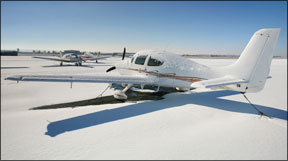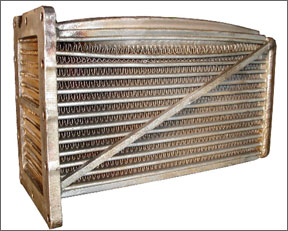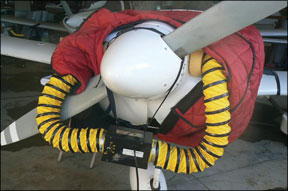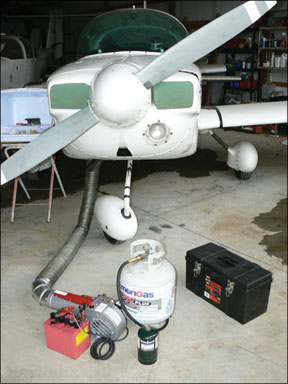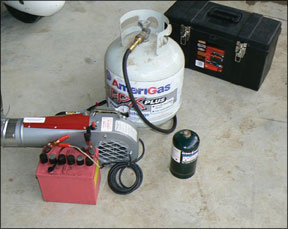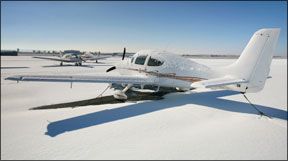After watching me horse around with a Piper Cub one day years ago, an old timer gave me a stern look and the comment, “Son, that aint a car.” Even in my youth I realized it was a good point that applies to most aspects of aviation, but recently I recognized its wisdom concerning cold-weather starts. Everybody knows that preheating aircraft engines is recommended, but so is exercise and a good diet. You dont preheat your car to drive to the airport, so whats the big deal? One engine is much the same as another, isnt it? Not really. 288 The main difference between automobile engines and airplane engines is the materials they are made of. And the oil they use. And the fuel they use. And the machines they power. And the way they are operated. Okay; just about everything involving airplane engines makes cold-weather preheating important. Metallurgy 101 Lets start with what they are made of-mostly aluminum and steel. One of the problems is that aluminum thermally expands and contracts at about twice the rate as steel. Another problem is that engines are usually assembled at room temperature, and the critical clearances are based on that. For example, on Continentals 520 cubic-inch engines the normal clearance between the steel crankshaft and the bearings held in the aluminum crankcase is a little less than two thousandths of an inch-actually 1.8 thousandths. According to tests done in Minnesota by the folks at Tanis Aircraft Services, at -20 deg. F this critical clearance is reduced by about two thousandths because the aluminum contracts more than the steel. Even without complicated math you can see that at very cold temperatures there is virtually no clearance between the crankshaft and the bearings, much the same as a press fit of a collar on a shaft. In short, the steel is too fat for the aluminum hole. With no clearance there is no room for a film of lubricating oil and every rotation of that crankshaft involves metal-to-metal contact with the bearings. The bearings in question come in two halves, and they are held in place by little tabs that fit into little grooves in the crankcase. With too tight a fit you could get a “spun bearing.” The bearings can rotate in the crankcase misaligning the holes supplying oil to the bearing-to-crank interface. If this happens, even after warmup, the bearings will be 288 starved for oil and engine seizure is imminent. A new or freshly overhauled engine is most susceptible to spun bearings as a high-time engine usually has more clearance due to worn parts. On the other end of the engine we have the opposite problem: the aluminum is too fat for the steel hole. First, understand that cylinders should be straight when operating-it makes the piston slide up and down easier. During normal operation the top of a steel cylinder (where the fire is) runs hotter than the bottom and thus expands to a bigger size. To make this work out, cylinders are manufactured with a “choke:” At room temperature the top portion is slightly smaller than the rest, so at operating temperature the entire cylinder is about the same diameter. But when you start a cold engine the aluminum piston slides up and down in the cylinder as gasoline fueled flames burn on its surface. As it warms, the relatively small piston expands at about twice the rate of the steel alloy around it. The aluminum piston gets fat quickly, the steel barrel gets fat slowly, and for a while the piston is too big for the hole. Cylinder wall scuffing is a direct result of cold starts. You may not notice it but engine overhaulers see the scratches at the cylinder choke. Between the bottom and top ends is another problem area. The steel wrist pin that holds the aluminum piston to the connecting rod is a miniature version of the earlier mentioned crankshaft/crankcase situation. If too tight, the piston cant rotate on the wrist pin and is stuffed up into the cylinder while cocked off to one side, scuffing the piston skirt against the cylinder wall. If the normally free-floating wrist pin is touching one side of the cylinder it, too, can make its own mark evident to engine rebuilders. The main advantage of preheating is to increase critical clearances. You can see that with virtually no clearance between two pieces of metal, no amount of oil pressure will help. Now, to be fair, most of your engine starts are not at arctic temperatures. But your engine was assembled in about the same temperature as 288 the room youre in now and realize that merely freezing temperatures are half of the way from there to 20 below. Chilled Oil Years ago I was taught to hand-prop the engine a few turns to “loosen the oil” before a cold-weather start. From the above discussion you can see that it probably isnt the oil causing the engine to feel stiff. Its the drag of tight metal parts rotating against each othe,r and the simple act of rotating the prop by hand has been known to spin crank bearings at very low temperatures. I now know I probably did more damage to those engines than good. No doubt, oil does get thick when cold. Oil pump gears can cavitate or carve out a hole in the thick mass of oil and spin in this cavity. Depending on where your oil pressure pick-up is located you might have an indication of pressure with little or no actual oil flow through the engine. If the pump does manage to move oil, it may not be able to force it through the small passages leading to critical parts. A large part of your engines lubrication comes from oil splash but thick oil doesnt sling too well. Another vulnerable component of your engine is the oil cooler. Congealed oil pushed by pressure can bulge coolers into what Wayne Thomas of Pacific Oil Cooler Service calls “The Aluminum Football.” The oil cooler pictured at the top of this page is an example. He describes a situation where cold oil bypasses the cooler, just as it should when cold. As the engine warms up, the vernatherm closes off the bypass and oil tries to flow through the cooler, but the congealed mass wont allow flow. The pressure builds until the oil is forced past the spring loaded seat, then the spring snaps it closed again. If the plane goes flying the oil in the cooler never gets a chance to warm and the vernatherm cycles open and closed, causing damaging pressure 288 spikes. The pressure gauge rarely shows this hammering so pilots have no indication anything is amiss. If you are going to preheat, make sure the engine, oil and all components get preheated. The use of multi-viscosity oil helps during winter. By improving the pourability at low temperatures these oils flow better than a straight weight, but dont solve all the problems associated with cold weather starts. Thick Fuel? Consider also the fuel we use in airplanes: Avgas doesnt vaporize as readily as automotive fuel, an admirable trait when combating vapor lock at high altitudes and temperatures but a potential problem source for winter starts. Have you ever watched a cold-weather start? It usually involves labored cranking, a lot of priming and glare-shield pounding, dripping fuel, the occasional small exhaust fire and finally a belch of smoke signaling dinosaur-juice combustion. The typical scenario is this: Were ready to start so we prime a few strokes and crank the engine. It doesnt start, so we prime some more and crank some more. A few cycles of this and the battery is dying, fuel is dripping from the carburetor, the cylinder walls have been washed of any oil they had, and the fire danger is high. Think about this from the engines perspective. It needs fuel vapor with the right amount of air to be ignited by a spark. If you give it these things the engine will run. Instead, what most people do is put liquid fuel into the engine and try to burn it 288 while simultaneously trying to pump it out the exhaust. Next time you prime, give the fuel time to vaporize. If your primer goes directly into the cylinders, give a few shots and wait. If you have a fuel injection system that primes with a boost pump, do that and wait. If your primer shoots only into the carb or induction system, prime a few strokes then crank four of five blades, then wait. And I mean wait. Three or four minutes wait. Get out your charts, adjust your headphones, brief your passengers, clean your sunglasses, but wait. Now, before you crank, pull out the primer to fill it for a full stroke or be ready with the boost pump. Chances are the engine will start and, after it fires, you can help it along with some prime or boost. If it doesnt start and you have primed sufficiently, you may need to wait even more. Pouring more liquid fuel in the system is rarely the answer. Try this the next time you fly, even if its warm outside. You will find your summertime starts will benefit from this technique. Remember how the engine wants vapor, air and spark? Weve discussed the vapor/air mix but if you arent careful you could come up short on spark. There is a possibility that the engine starts, you get a couple of snorts out of the exhaust, the prop turns a few blades and then the engine dies. You may have frosted over the spark plugs. Moisture produced by the combustion process can condense on cold plugs. You can crank all day and they will not fire. The solution is to remove the plugs and dry them in an oven, or preheat the entire engine above the condensation point. Its a toss-up as to which will take more time and effort. The Rest Of The Airplane Many airplanes design makes cold starting difficult. Batteries lose power in low temperatures and some airplanes have batteries a long way from the starter, with the attendant loss of power through long runs of wiring. If your battery lives in the engine compartment it will benefit from a preheat, but batteries in fuselages and baggage compartments get no love. This is one of the reasons for a whole-airplane preheat-either by spending the night in a heated hangar or by separate engine and cabin preheats. While were talking about the cabin, consider the avionics and instruments. Gyros turn on oiled bearings that react like all cold-lubed things. They are slow to spin up and the lack of lubrication doesnt do their delicate parts any good. Tachometer, throttle and prop cables are stiff. Digital displays and LCDs can be weak or non-readable. Push-to-test lights stick and old plastic trim can crack. Using the airplanes heater, especially the gasoline-fired ones typically found in piston twins, can put too much heat in the cabin too fast and damage ducting. Some windshields are prone to cracking if heated too quickly. We used to start a twin turboprop commuter airliner at -40 deg. F in Gunnison, Colo. The engines would start but when we turned on engine bleed air to the air conditioning packs, the demand for heat was so great it would trip the duct overheat sensors within minutes, driving the mix valves to full cold. After a cool-down and reset, the process would repeat. We learned to ask for just a little heat at a time and plan on a slow warm-up. Plan to heat your airplane slowly, too. We operate airplanes differently than cars. On a cold morning you start your car and motor away at a low power setting. It may be many miles before you get to an open stretch of road and apply much throttle. Consider an airplane engine that is asked to provide full power for takeoff usually within minutes after start. I used to operate deHavilland Beavers in Alaska. We would start the engines and let them idle for at least 45 minutes to warm up. Even then, the first takeoff of the day was oil pressure limited. The technique was to advance the throttle until oil pressure approached the red line, then add no more. Takeoff and climb occurred with whatever power was available. After flying for a while, the hundreds of pounds of radial engine and its four gallons of oil were warm enough for normal operations. Winter is here. Take care of your engine and your airplane. It aint a car. Mike Gugeler flew for years in Alaska and is now Colorado-based.